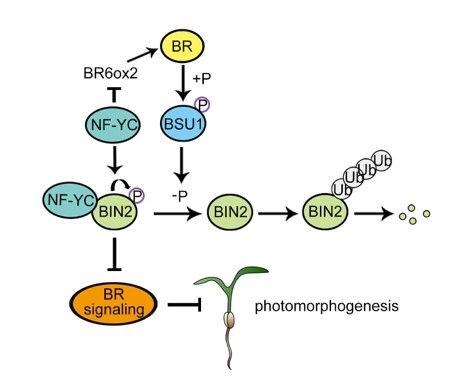

Plant seedlings generally undergo a series of developmental changes to seek light from seed germination to seedling emergence. Once exposed in the light, plants undergo a series of photomorphogenic responses, which require to quickly remove the repressors accumulated in the dark and activate the related promotors. Brassinosteroids, one of the main hormones that promotes plant growth and also one inhibitor which represses the photomorphogenesis, plays an important regulatory role in seedling growth, including rapidly hypocotyl elongation, during seed germination to seedling emergence and promotes skotomorphogenesis. Although a large studies fuse on light signal regulating the inhibitors of photomorphogenesis, the light-controlled regulatory details in BR pathway remain unclear. Therefore, it is great significance for clarifying the regulatory mechanism of phtomorphogenesis by exploring the relationship between light singling and BR pathway.
Dr. ZHANG Wenbin from South China Botanical Garden of Chinese Academy of Sciences have reported a mechanism of Light inhibits BR pathway. In this study, a combination of molecular, biochemical and genetic approaches is used to uncover a dual role of NF-YCs in repressing BR biosynthesis and signaling, providing mechanistic insights into how light antagonizes the BR pathway to ensure photomorphogenic growth in Arabidopsis.

Figure. A working model of the role of NF-YCs in light-triggered repression of the BR pathway
In the light, NF-YCs directly associate with the promoter of the BRbiosynthesis gene BR6ox2 and repress its transcription, thereby inhibiting BR biosynthesis. NF-YCs also interact with the BR signaling repressor BIN2 to induce its autophosphorylation, which facilitates the stabilization of BIN2 and enhances the suppression of BR signaling (Figure). The dual roles of NF-YCs in repressing BR biosynthesis and signaling allow plants to rapidly inhibit BR responses, which consequently maintains their steady photomorphogenic growth in the light. This model provides a mechanistic understanding of how the BR pathway is modulated for light- regulated plant growth.
The study has been published in the online edition of the international journal The Plant Cell. For further reading, please refer to: https://doi.org/10.1093/plcell/koab112.

